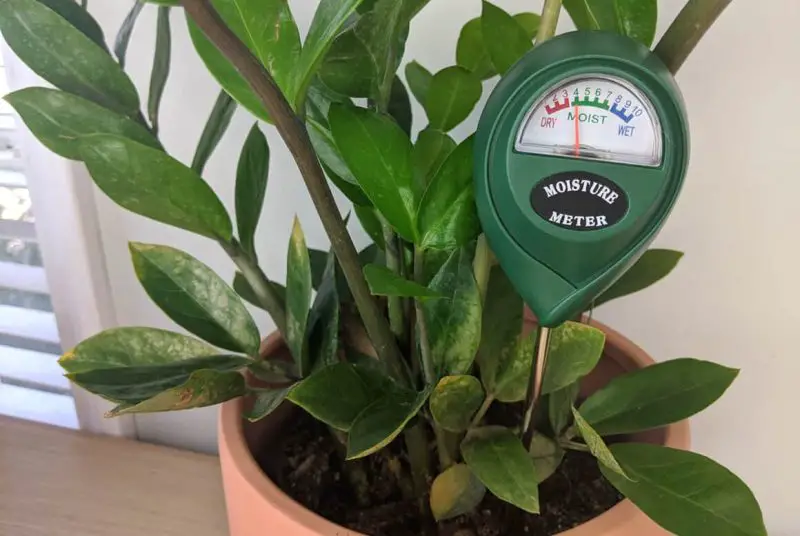I have been into houseplant gardening for two decades and ZZ plants (Zamioculcas Zamiifolia) are my favorite choice since they require minimal maintenance. But this does not make them invincible to the common ZZ plants problems.
If you notice your ZZ plant leaves curling, it is an indicator something is wrong. You need to re-assess your ZZ plant care routine to determine the root cause. But do not worry since fixing curling leaves on ZZ plant is a no-brainer task.
We wrote this article to help you identify the exact cause ZZ plant leaves curling and its respective solution. Take the time to read through until the end and also discover the reasons for ZZ plant leaves splitting.
10 Causes of ZZ Plant Leaves Curling
Having houseplants with dark green leaves and lush appearance is the dream of every indoor plant enthusiasts here in the United States. But ZZ plant leaves drying and curling can be heartbreaking among many gardeners. (Source: UNIVERSITY OF CONNECTICUT) Below are the possible causes of curly leaves on ZZ plants:
Pest Infestation
ZZ plants are less vulnerable to insect infestation. But spider mites and mealybugs will still find their way around the plant due to its lush appearance. These insects feed on the leaf sap and inject venom to cause some stress.
The damaged leaves start curling and eventually turn brown. The ZZ plant curl the leaves to protect itself from further harm by pests. Handling severe pest infestations can be a nightmare for novice or professional houseplant enthusiasts.
We recommend isolating the affect ZZ plant from other houseplants to prevent the pests from spreading. You can remove the pests manually using a damp cloth or cotton swab dipped in rubbing alcohol. To eradicate the pests, use insecticidal soap or neem oil on the plant.
Maintain good plant hygiene by regularly inspecting your ZZ plant for any signs of pests. Wipe the leaves periodically with a damp cloth to keep them clean. Avoid overwatering and provide adequate airflow around the plant to discourage pests.
Underwatering
ZZ plants thrive in a moist soil that never gets soggy. Insufficient soil moisture will make your ZZ plant leaves to curl overtime since it wants to reduce the transpiration rate. The technique help the plant minimize water loss through the leaf surface.
Water your plant thoroughly until it drains out of the container via the drainage holes. Be sure to determine the soil moisture more often before watering the houseplant. Insert your finger in 2-3 inches of the soil to feel if it is dry.
Ensure that the pot has drainage holes to prevent water from sitting in the soil and causing root rot. Maintain a consistent watering routine, taking into account factors like temperature, humidity, and the plant’s specific needs.
Adjust watering frequency accordingly, providing more water during hot and dry periods and reducing it during cooler months. Regularly monitor the soil moisture to avoid both overwatering and underwatering.
Overwatering
Overwatered ZZ plant will experience curly leaves since the roots cannot access oxygen and other vital nutrients. The houseplant will later suffer from root rot overtime. ZZ plant leaves curling, turning yellow and brown are the main signs of overwatering.
Transplant the houseplant to another container with drainage holes and fresh well-draining soil. Avoid keeping your ZZ plant in standing water to prevent root rot. Besides that determine the soil moisture level before watering your plant.
Insert your finger in 2-3 inches of the topsoil, if it feels dry then water the plant. Be sure to adjust your watering frequency according to the environmental conditions and plant needs. Improve the potting mix drainage to avoid overwatering.
Lack of Humidity
ZZ plants are tropical plants that thrive in warm and humid environment. Indoor space is highly susceptible to humidity fluctuations due to heating vents and air conditioners. ZZ plant wrinkled stem and leaves curling are signs of low humidity.
Use an electric humidifier to increase the humidity level around your ZZ plant. You can also mist the leaves to revive them from curling appearance. ZZ plants curl their leaves in low humidity environment to prevent water loss through transpiration.
We do not recommend misting dirty leaves to increase humidity since it will invite many ZZ plant problems like diseases and pests. Wipe the leaves to remove dirt and mist to create a more humid microclimate around your houseplant.
Incorrect Sunlight Exposure
ZZ plants thrive in bright indirect sunlight since they are tropical plants. If your ZZ plant receives too much direct sunlight, the leaves will begin to curl and scorch. ZZ plant leaves turning yellow and curling is a sign of incorrect sunlight exposure.
Insufficient light will make your ZZ plant stems leggy with weak and curly leaves. Relocate the houseplant near a north or east-facing window where it will receive bright indirect sunlight. Ensure the windows have sheer curtains to reduce the sunlight intensity.
You can also use artificial grow lights if you find it challenging to control natural light exposure. It is the best option for houseplant enthusiasts living in drier states in the US and parts of Europe. Always rotate the plant to promote even growth.
Extreme Temperature
ZZ plants are sensitive houseplants when it comes to ideal temperature. Extreme temperature conditions can make your ZZ plant leaves to curl. High temperature and low humidity can lead to water loss through transpiration leading to leaves curling.
Cold temperature can also damage the leaf cells to cause the curling appearance. Keep your ZZ plant in an environment with a temperature range of 65-75°F (18-24°C), which is the ideal range for its growth.
Avoid keeping your houseplant near drafts, heating vents, and air conditioning units since they can create extreme temperatures. Ensure your houseplant gets adequate air circulation in the summer to reduce heat buildup and avoid cold drafts by all means in winter.
Overfertilization
ZZ plants need nutrients to stay lush and healthy. But excessive fertilizer application can lead to salt buildup in the soil overtime. Excess salt causes root burn and other stresses to your favorite indoor plant like leaves curling problem.
I recommend flushing the potting mix to leach the excess salt. Adopt this practice every three months during the growing season to prevent salt accumulation in the soil and indoor ZZ plant leaves curling problems.
Use homemade fertilizer or organic fertilizer to feed your ZZ plant instead of its artificial counterpart. It will avoid issues relating to plant leaves curling and turning brown. If you opt for the artificial fertilizer, dilute it and follow all the instructions on the package to administer the right dosage.
ZZ plant leaves turning yellow is a sign of under-fertilization. Be sure to adjust the frequency and application strengths depending on the plant needs. The most exciting thing is that ZZ plants are tolerant to lower nutrient levels.
Nutritional Deficiencies
Essential nutrients promote lush appearance and healthy growth among the ZZ plants. If your notice your ZZ plant leaves curling, it could be a sign of nutritional deficiencies. The stress sign is an indicator that your plant lack vital nutrients.
Apply a dilute balance fertilizer to your plant and supply it with essential nutrients or minerals. It will help prevent plant leaves curling and turning yellow. Follow the instructions on the fertilizer package to determine the appropriate dosage and frequency of application.
I recommend applying fertilizer to your houseplant during the growing season. Avoid over-fertilization since this could lead to the ZZ plant leaves turning brown overtime. If you suspect specific nutrient deficiencies, you can apply a foliar spray or a targeted nutrient supplement.
Root Bound Problem
ZZ plants are vulnerable to root bound problem since they are fast-growing tropical plants. Roots outgrowing the container could lead to curly leaves due to limited access to water and nutrients around the roots.
I recommend removing your ZZ plant from the pot and examine the root system. If the roots are densely filled the pot, transplant into a larger container. Ensure the chosen pot has drainage holes and slightly larger than the current previous one.
Loosen the root ball and trim excess or damaged roots. Plant your ZZ plant in a well-draining potting mix and provide ultimate care. We recommend transplanting your houseplant in spring since it the period where it will experience rapid growth.
Plant Diseases
ZZ plants are less susceptible to common plant diseases. But this does not make them invincible to fungal diseases like root rot or leaf spot disease. These plant diseases can contribute to leaves curling for defense mechanisms.
Handling severe plant diseases among ZZ plants is not a walk in the park. We recommend consulting a plant care professional or research common ZZ plant diseases to narrow down the possibilities. Once the disease is identified, take appropriate action.
Isolate the plant from other houseplants and remove the severely affected leaves. Improve airflow around the plant, adjust watering practices, and use fungicides or bactericides recommended for the treatment.
This may include removing and destroying severely infected leaves or parts of the plant, improving airflow around the plant, adjusting watering practices to avoid excessive moisture, or using targeted fungicides or bactericides is recommended for the specific disease.

Final Thoughts from Experts
Do not worry when you notice your ZZ plant leaves curling since this is not a dead end. Curling leaves among houseplants is an indicator of an inappropriate care routine. Changing the current ZZ plant care regime will help revive your favorite plant.
The golden rule is to identify the exact cause and fix it. We hope the information above will help you identify the causes and their respective fixing tips. Feel free to share the information with your friends or other houseplant enthusiasts. (Source: Michigan State University)
People Who Read This Also Read:
- How to Care for ZZ Plant.
- ZZ Plant Leaves Drooping.
- ZZ Plant Leaves Turning Yellow.
- ZZ Plant Leaves Turning Brown.







